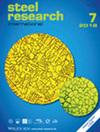利用机器学习和遗传算法优化高炉炼铁工艺
IF 1.9
3区 材料科学
Q2 METALLURGY & METALLURGICAL ENGINEERING
引用次数: 0
摘要
高炉是一种多相逆流填料床反应器,利用冶金焦和煤粉将块料、烧结矿和球团等含铁材料转化为热金属。投入材料的质量对高炉性能、热金属质量和炼钢厂经济效益有重大影响。由于熔炉参数众多,操作员很难仅凭经验确定高效安全运行所需的最佳设置。在热金属硅(HMSi)和温度(HMT)的约束下,制定并使用遗传算法解决了最大化高炉生产率(PROD)和最小化燃料率(FR)的多目标优化问题。针对 PROD、FR、HMSi 和 HMT 开发了机器学习 (ML) 模型,并使用工业高炉的数据进行了测试。获得了帕累托最优解以及关键操作变量的最优设置。结果表明,在稳定状态下,PROD 和 FR 可提高 ≈3-5%。基于 ML 模型的整体优化框架可作为高炉数字孪生系统的一部分,针对给定的原材料质量实时有效地操作高炉。本文章由计算机程序翻译,如有差异,请以英文原文为准。
Optimization of Blast Furnace Ironmaking Using Machine Learning and Genetic Algorithms
Blast furnace is a multiphase counter‐current packed bed reactor that converts iron‐bearing materials such as lumps, sinter, and pellets into hot metal using metallurgical coke and pulverized coal. The quality of input materials has a significant impact on furnace performance, hot metal quality and steel plant economics. It is difficult for operators to identify the optimal settings required for efficient and safe operation based on their experience alone, given the large number of furnace parameters. A multiobjective optimization problem for maximizing furnace productivity (PROD) and minimizing fuel rate (FR) with constraints on hot metal silicon (HMSi) and temperature (HMT) is formulated and solved using a genetic algorithm. Machine learning (ML) models are developed for PROD, FR, HMSi, and HMT and tested with data from an industrial blast furnace. Pareto‐optimal solutions along with optimal settings for key manipulated variables are obtained. It is demonstrated that PROD and FR can be improved by ≈3–5% at steady state. The overall ML model‐based optimization framework can be used as part of a blast furnace digital twin system to operate the furnace efficiently in real‐time for the given quality of raw materials.
求助全文
通过发布文献求助,成功后即可免费获取论文全文。
去求助
来源期刊

steel research international
工程技术-冶金工程
CiteScore
3.30
自引率
18.20%
发文量
319
审稿时长
1.9 months
期刊介绍:
steel research international is a journal providing a forum for the publication of high-quality manuscripts in areas ranging from process metallurgy and metal forming to materials engineering as well as process control and testing. The emphasis is on steel and on materials involved in steelmaking and the processing of steel, such as refractories and slags.
steel research international welcomes manuscripts describing basic scientific research as well as industrial research. The journal received a further increased, record-high Impact Factor of 1.522 (2018 Journal Impact Factor, Journal Citation Reports (Clarivate Analytics, 2019)).
The journal was formerly well known as "Archiv für das Eisenhüttenwesen" and "steel research"; with effect from January 1, 2006, the former "Scandinavian Journal of Metallurgy" merged with Steel Research International.
Hot Topics:
-Steels for Automotive Applications
-High-strength Steels
-Sustainable steelmaking
-Interstitially Alloyed Steels
-Electromagnetic Processing of Metals
-High Speed Forming
 求助内容:
求助内容: 应助结果提醒方式:
应助结果提醒方式:


